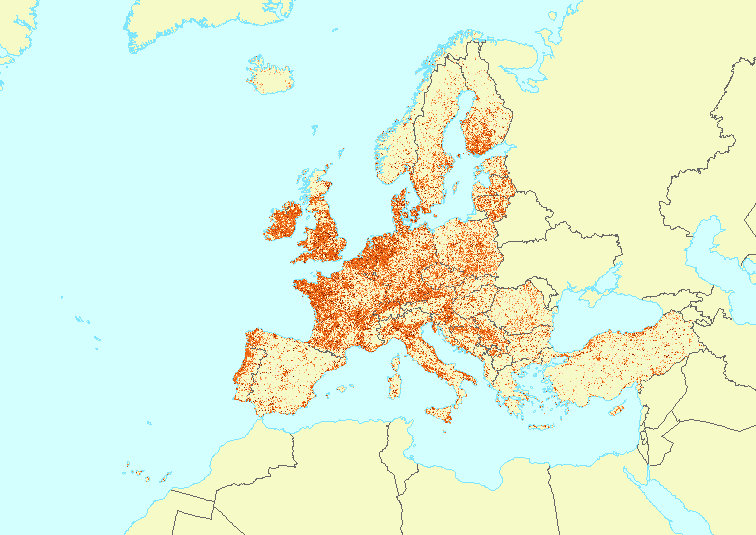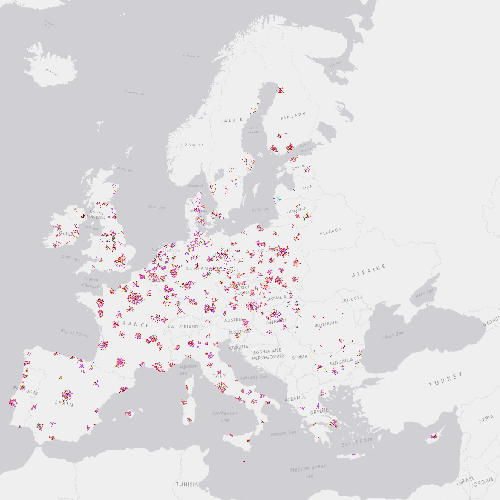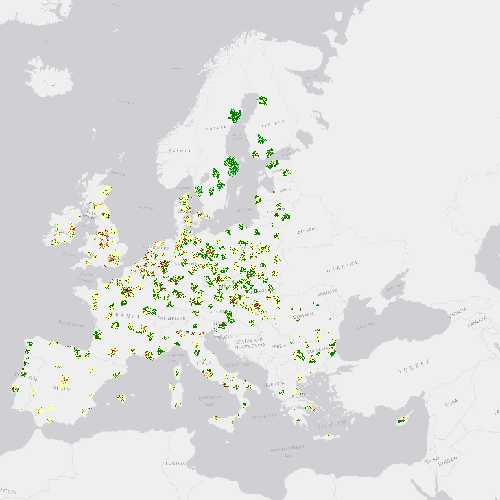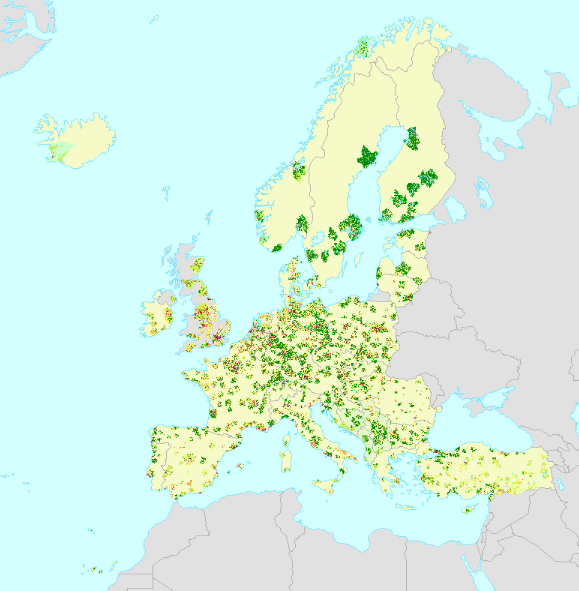IDP_topics_Urban
Type of resources
Available actions
Topics
INSPIRE themes
Keywords
Contact for the resource
Provided by
Years
Formats
Representation types
Update frequencies
status
Resolution
-

The Urban Atlas provides pan-European comparable land use and land cover data for Functional Urban Areas (FUA). The Street Tree Layer (STL) is a separate layer from the Urban Atlas 2012 LU/LC layer produced within the level 1 urban mask for each FUA. It includes contiguous rows or a patches of trees covering 500 m² or more and with a minimum width of 10 meter over "Artificial surfaces" (nomenclature class 1) inside FUA (i.e. rows of trees along the road network outside urban areas or forest adjacent to urban areas should not be included). Urban Atlas is a joint initiative of the European Commission Directorate-General for Regional and Urban Policy and the Directorate-General for Enterprise and Industry in the frame of the EU Copernicus programme, with the support of the European Space Agency and the European Environment Agency.
-

The degree of urban dispersion (DIS) characterizes the settlement pattern in a geometric perspective and is based on the distances between any two points within built-up areas (average taken over all possible pairs of points, up to a maximum distance called the horizon of perception). DIS is input to the Weighted Urban Proliferation (WUP) metric, which has three components: the percentage of built-up areas (PBA), the dispersion of the built-up areas (DIS), and land uptake per person (LUP). The new urban sprawl metric, named "Weighted Urban Proliferation“ (WUP) is based on the following definition of urban sprawl: the more area is built over in a given landscape (amount of built-up area) and the more dispersed this built-up area is in the landscape (spatial configuration), and the higher the uptake of built-up area per inhabitant or job (lower utilisation intensity in the built-up area), the higher the degree of urban sprawl. The DIS dataset is used in EEA's Urban Sprawl work indicating urbanisation impacts on the land system. It covers EEA39.
-

The Urban Atlas provides pan-European comparable land use and land cover data for Functional Urban Areas (FUA). The Urban Atlas Change layers have become available from 2012 and only for all FUAs that have been covered in both 2006 and 2012 reference years. Urban Atlas is a joint initiative of the European Commission Directorate-General for Regional and Urban Policy and the Directorate-General for Enterprise and Industry in the frame of the EU Copernicus programme, with the support of the European Space Agency and the European Environment Agency.
-

Percentage of built-up area (PBA) measures how large the built-up areas are (in % of the landscape). PBA is a component of the new urban sprawl metric, named "Weighted Urban Proliferation“ (WUP). WUP is based on the following definition of urban sprawl: the more area is built over in a given landscape (amount of built-up area) and the more dispersed this built-up area is in the landscape (spatial configuration), and the higher the uptake of built-up area per inhabitant or job (lower utilisation intensity in the built-up area), the higher the degree of urban sprawl. Weighted Urban Proliferation (WUP) metric has three components: the percentage of built-up areas (PBA), the dispersion of the built-up areas (DIS), and land uptake per person (LUP). Values for landscapes of differing sizes can be directly compared because PBA is an intensive metric, i.e., the value does not depend on the size of the landscape. The PBA dataset is used in EEA's Urban Sprawl work indicating urbanisation impacts on the land system. It covers EEA39.
-

The degree of urban dispersion (DIS) characterizes the settlement pattern in a geometric perspective and is based on the distances between any two points within built-up areas (average taken over all possible pairs of points, up to a maximum distance called the horizon of perception). DIS is input to the Weighted Urban Proliferation (WUP) metric, which has three components: the percentage of built-up areas (PBA), the dispersion of the built-up areas (DIS), and land uptake per person (LUP). The new urban sprawl metric, named "Weighted Urban Proliferation“ (WUP) is based on the following definition of urban sprawl: the more area is built over in a given landscape (amount of built-up area) and the more dispersed this built-up area is in the landscape (spatial configuration), and the higher the uptake of built-up area per inhabitant or job (lower utilisation intensity in the built-up area), the higher the degree of urban sprawl. The DIS dataset is used in EEA's Urban Sprawl work indicating urbanisation impacts on the land system. It covers EEA39.
-

The European Urban Atlas provides reliable, inter-comparable, high-resolution land use maps for 305 Large Urban Zones and their surroundings (more than 100.000 inhabitants as defined by the Urban Audit) for the reference year 2006 in EU member states. The GIS data can be downloaded together with a map for each covered urban area and a report with the metadata for the respective area. Additional information (product description, mapping guidance and class description) can be found at https://www.eea.europa.eu/data-and-maps/data/urban-atlas/#tab-methodology. Urban Atlas is a joint initiative of the European Commission Directorate-General for Regional and Urban Policy and the Directorate-General for Enterprise and Industry in the frame of the EU Copernicus programme, with the support of the European Space Agency and the European Environment Agency.
-

The European Urban Atlas provides reliable, inter-comparable, high-resolution land use and land cover data for 800 Functional Urban Areas (FUA) with more than 50,000 inhabitants for the reference year 2012 in EEA39 countries (EU, EFTA and Western Balkan countries as well as Turkey and United Kingdom). The spatial data can be downloaded together with a map for each FUA covered and a report with the metadata for the respective area. Urban Atlas is a joint initiative of the European Commission Directorate-General for Regional and Urban Policy and the Directorate-General for Defence Industry and Space in the frame of the EU Copernicus programme, with the support of the European Space Agency and the European Environment Agency.
-

Urban Permeation (UP) is a measure of the permeation of a landscape by built‑up areas; it describes the degree to which the landscape is permeated by patches of built-up area. It is calculated from the new urban sprawl metric "Weighted Urban Proliferation“ (WUP). Weighted Urban Proliferation is based on the following definition of urban sprawl: the more area is built over in a given landscape (amount of built-up area) and the more dispersed this built-up area is in the landscape (spatial configuration), and the higher the uptake of built-up area per inhabitant or job (lower utilisation intensity in the built-up area), the higher the degree of urban sprawl. The WUP metric has three components: the percentage of built-up areas (PBA), the dispersion of the built-up areas (DIS), and land uptake per person (LUP). UP is a product of PBA and DIS. It represents the spread of the built-up areas in the landscape. UP is expressed in urban permeation units per m2 of land (UPU/m2). The UP dataset is used in EEA's Urban Sprawl work indicating urbanisation impacts on the land system. It covers EEA39.
-

Urban Permeation (UP) is a measure of the permeation of a landscape by built‑up areas; it describes the degree to which the landscape is permeated by patches of built-up area. It is calculated from the new urban sprawl metric "Weighted Urban Proliferation“ (WUP). Weighted Urban Proliferation is based on the following definition of urban sprawl: the more area is built over in a given landscape (amount of built-up area) and the more dispersed this built-up area is in the landscape (spatial configuration), and the higher the uptake of built-up area per inhabitant or job (lower utilisation intensity in the built-up area), the higher the degree of urban sprawl. The WUP metric has three components: the percentage of built-up areas (PBA), the dispersion of the built-up areas (DIS), and land uptake per person (LUP). UP is a product of PBA and DIS. It represents the spread of the built-up areas in the landscape. UP is expressed in urban permeation units per m2 of land (UPU/m2). The UP dataset is used in EEA's Urban Sprawl work indicating urbanisation impacts on the land system. It covers EEA39.
-

The European Urban Atlas provides reliable, inter-comparable, high-resolution land use and land cover data for 785 Functional Urban Area (FUA) for the 2012 reference year in EEA38 countries (EU, EFTA and Western Balkan countries as well as Turkey) and United Kingdom. The spatial data can be downloaded together with a map for each FUA covered and a report with the metadata for the respective area. Urban Atlas is a joint initiative of the Commission Directorate-General for Regional and Urban Policy and the Directorate-General for Defence Industry and Space (DEFIS) in the frame of the EU Copernicus programme, with the support of the European Space Agency and the European Environment Agency.
 RUC Geo-Data catalogue
RUC Geo-Data catalogue